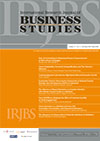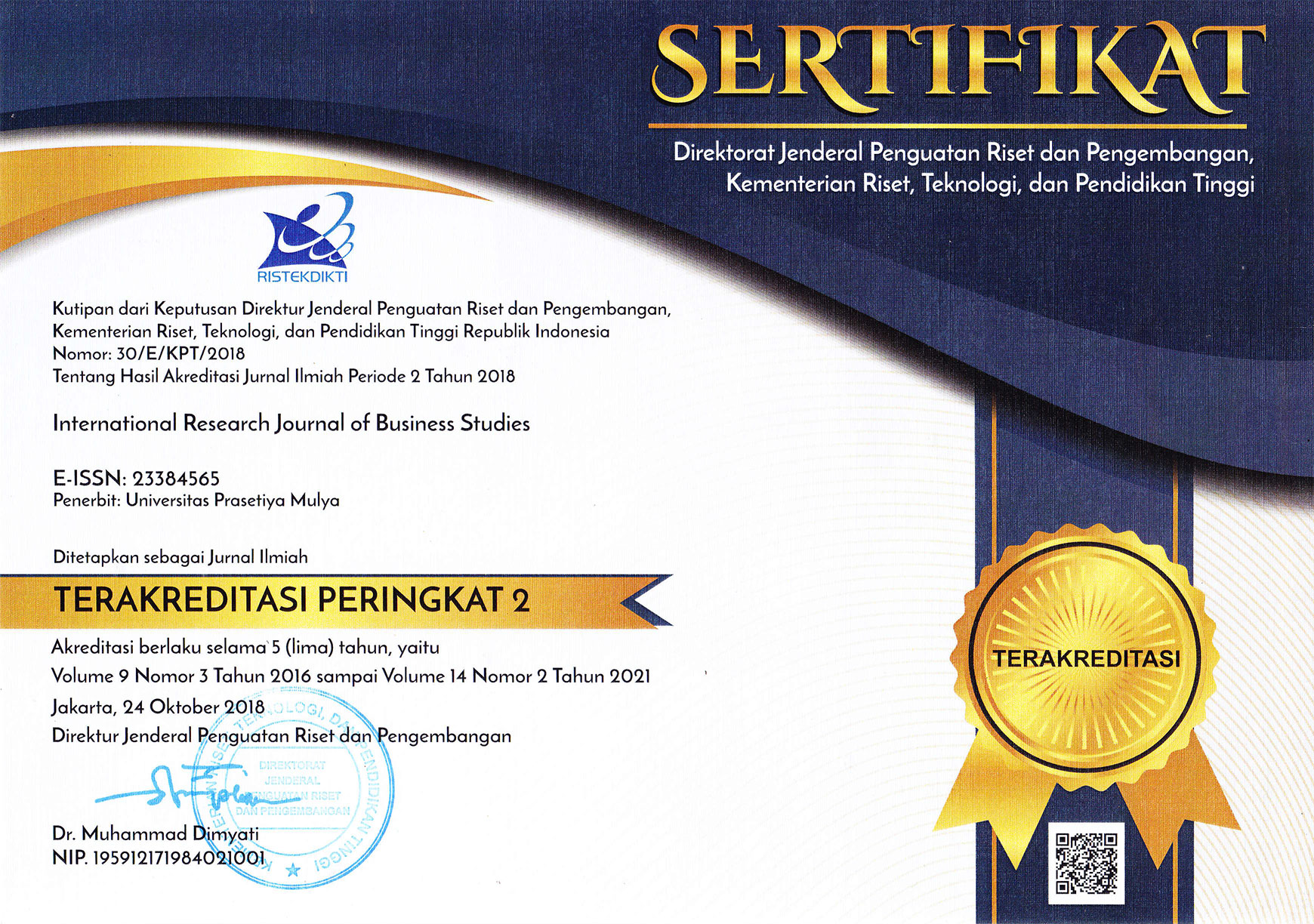Herding Behavior in Indonesian Investors
DOI:
https://doi.org/10.21632/irjbs.11.2.129-143Keywords:
Herding Behavior, LQ 45, stock index, Vector Autoregression (VARAbstract
This research attempts to investigate the herding behavior of the companies that invested in IDX LQ45 Index during 2014 through 2016. Herd behavior is the tendency of investors to follow other investors’ actions in the market. LQ45 was chosen as it comprises the most heavily-traded stocks of the Indonesian Stock Exchange. This research used Vector Autoregressive model to determine the effects of size and market return on the herding behavior. The Granger causality test suggests that there are dynamic interactions: (i) between size and herding behavior; and (ii) between market return and herding behavior. In addition, Variance Decomposition and Impulse Response reveal that market capitalization (size) has variable of the greater role in defining herding behavior, compared to that of market return.
References
Al-Shboul, M. (2012). Asymmetric Effects and the Herd Behavior in the Australian Equity Market. International Journal of Business and Management, 7(7), 121-140.
Baddeley, A. (2012). Working Memory: Theories, Models, and Controversies. Annual Review of Psychology, 63, 1-29.
Banerjee, A.V., (1992). A Simple Model of Herd Behavior. The Quarterly Journal of Economics, 107(3), 797-817.
Bickhandani, S. & Sharma, S. (2001). Herd Behavior in Financial Markets. IMF Staff Papers, 47(3), 279-310.
Bowe, M. & Domuta, D. (2004). Investor herding during financial crisis: A clinical study of the Jakarta Stock Exchange. PacificBasin Finance Journal, 12(4), 387-418.
Brunnermeier, M.K. (2001). Asset Pricing under Asymmetric Information. Oxford: Oxford University Press.
Chang, E.C., Cheng, J.W., & Khorana, A. (2000). An Examination of herd behavior in equity markets: an international perspective. Journal of Banking and Finance, 24, 1651-1679.
Chen, Y.F., Yang, S.Y., & Lin, F.L. (2012). Foreign Institutional Industrial Herding in Taiwan Stock Market. Managerial Finance, 38(3), 325-340.
Christie, W. G. & Huang, R. D. (1995). Following The Pied Paper: Do Foreign Individual Returns Herd Around the Market. Journal of Financial Analyst, 31-37.
Devenow, A. & Welch, I. (1996). Rational Herding in Financial Economics. Journal of European Economic Review, 40, 603-615.
Gunawan, Wijayanto, H., Achsani, N.A., & Rahman, L.O.A. (2011). Pendeteksian Perilaku Herding pada Pasar Saham Indonesia dan Asia Pasifik. Forum Statistika dan Komputasi, 16(2), 16-23.
Gutierrez, R.C., & Kelley, E.K. (2009). Institutional Herding and Future Stock Returns. Retrieved from Research Gate website:
https://www. researchgate.net/publication/228666518_Institutional_Herding_and_Future_Stock_Returns.
Harris, L. (2003). Trading and Exchanges: Market Microstructure for Practitioners. Oxfrod: Oxford University Press.
Hirshleifer, D. & Teoh, S.H. (2003). Herd Behavior and Cascading in Capital Markets: A Review and Synthesis. European Financial Management, 9, 25-66.
Indonesia Stock Exchange. (2016). Fact Book 2016. Jakarta: Indonesia Stock Exchange
Jogiyanto. (2000). Teori Portofolio dan Analisis Investasi. Yogyakarta: BPFE.
Kremer, S. & Nautz, D. (2013). Short-term Herding of Institutional Traders: New Evidence from the German Stock. European Financial Management, 19, 730-746.
Lakonishok, Shleifer, A., & Vishny, R. W. (1992). The impact of institutional trading on stock prices. Journal of Financial Economics, 32, 23–44.
Lan, Q.Q. & Lai, R.N. (2011). Herding and Trading Volume (University of Macau). Available online at http://dx.doi.org/10.2139/ssrn.1914208.s
Lindhe, E. (2012). Herd Behavior in Stock Markets: A Nordic Study (Master’s Thesis). Lund Universitet, Lund, Sweden.
Mabrouk, H.B. & Mohamed, F. (2013). Herding During Market Upturns and Downturns: International Evidence. The IUP Journal of Applied Finance, 19(2), 5-26.
Ramli, I., Agoes, S., & Setyawan, I. R. (2016). Information Asymmetry and The Role of Foreign Investors in Daily Transactions
During the Crisis: A Study of Herding in The Indonesian Stock Exchange. The Journal of Applied Business Research. 32 (1), 269-288.
Saastamoinen, J. (2008). Quantile Resression Analysis of dispersion of stock returns-evidence of herding?. Keskustelualoitteita 57, 1-19.
Sheldon, A. (2014). Global Mining Investing (eBook). Google Books.
Szyszka, A.(2013). Behavioral Finance and Capital Markets: How Psychology Influences Investors and Corporations. US: Palgrave Macmillan.
Testa, A. (2012). Path-Dependent Behavior with Asymmetric Information about Trader’s Type. Discussion Paper. University of Bonn, 1-36.
Venezia, I., Nashikkar, A., & Shapira, Z. (2010). Firm Specific and Macro Herding by Professional and Amateur Investors and their Effects on Market Volatility, Journal of Banking & Finance 35(7), 1599-1609.
Widarjono, A. (2013). Ekonometrika Teori dan Aplikasi. Yogyakarta: Ekonisia FE UII
Downloads
Submitted
Published
How to Cite
Issue
Section
License
Copyright (c) 2018 Maria Fransiska, Sumani, Willy, Stevanus Pangestu

This work is licensed under a Creative Commons Attribution-ShareAlike 4.0 International License.
Journal Author(s) Rights
For IRJBS to publish and disseminate research articles, we need publishing rights (transferred from the author(s) to the publisher). This is determined by a publishing agreement between the Author(s) and IRJBS. This agreement deals with the transfer or license of the copyright of publishing to IRJBS, while Authors still retain significant rights to use and share their own published articles. IRJBS supports the need for authors to share, disseminate and maximize the impact of their research and these rights, in any databases.
As a journal Author, you have rights to many uses of your article, including use by your employing institute or company. These Author rights can be exercised without the need to obtain specific permission. Authors publishing in IRJBS journals have comprehensive rights to use their works for teaching and scholarly purposes without needing to seek permission, including:
- use for classroom teaching by Author or Author's institution and presentation at a meeting or conference and distributing copies to attendees;
- use for internal training by the author's company;
- distribution to colleagues for their research use;
- use in a subsequent compilation of the author's works;
- inclusion in a thesis or dissertation;
- reuse of portions or extracts from the article in other works (with full acknowledgment of the final article);
- preparation of derivative works (other than commercial purposes) (with full acknowledgment of the final article);
- voluntary posting on open websites operated by the author or the author’s institution for scholarly purposes,
(But it should follow the open access license of Creative Common CC-by-SA License).
Authors/Readers/Third Parties can copy and redistribute the material in any medium or format, as well as remix, transform, and build upon the material for any purpose, even commercially. Still, they must give appropriate credit (the name of the creator and attribution parties (authors' detail information), a copyright notice, an open access license notice, a disclaimer notice, and a link to the material), provide a link to the license, and indicate if changes were made (Publisher indicates the modification of the material (if any) and retain an indication of previous modifications.
Authors/Readers/Third Parties can read, print and download, redistribute or republish the article (e.g. display in a repository), translate the article, download for text and data mining purposes, reuse portions or extracts from the article in other works, sell or re-use for commercial purposes, remix, transform, or build upon the material, they must distribute their contributions under the same license as the original Creative Commons Attribution-ShareAlike (CC BY-SA).
This work is licensed under a Creative Commons Attribution-ShareAlike 4.0 International License.








